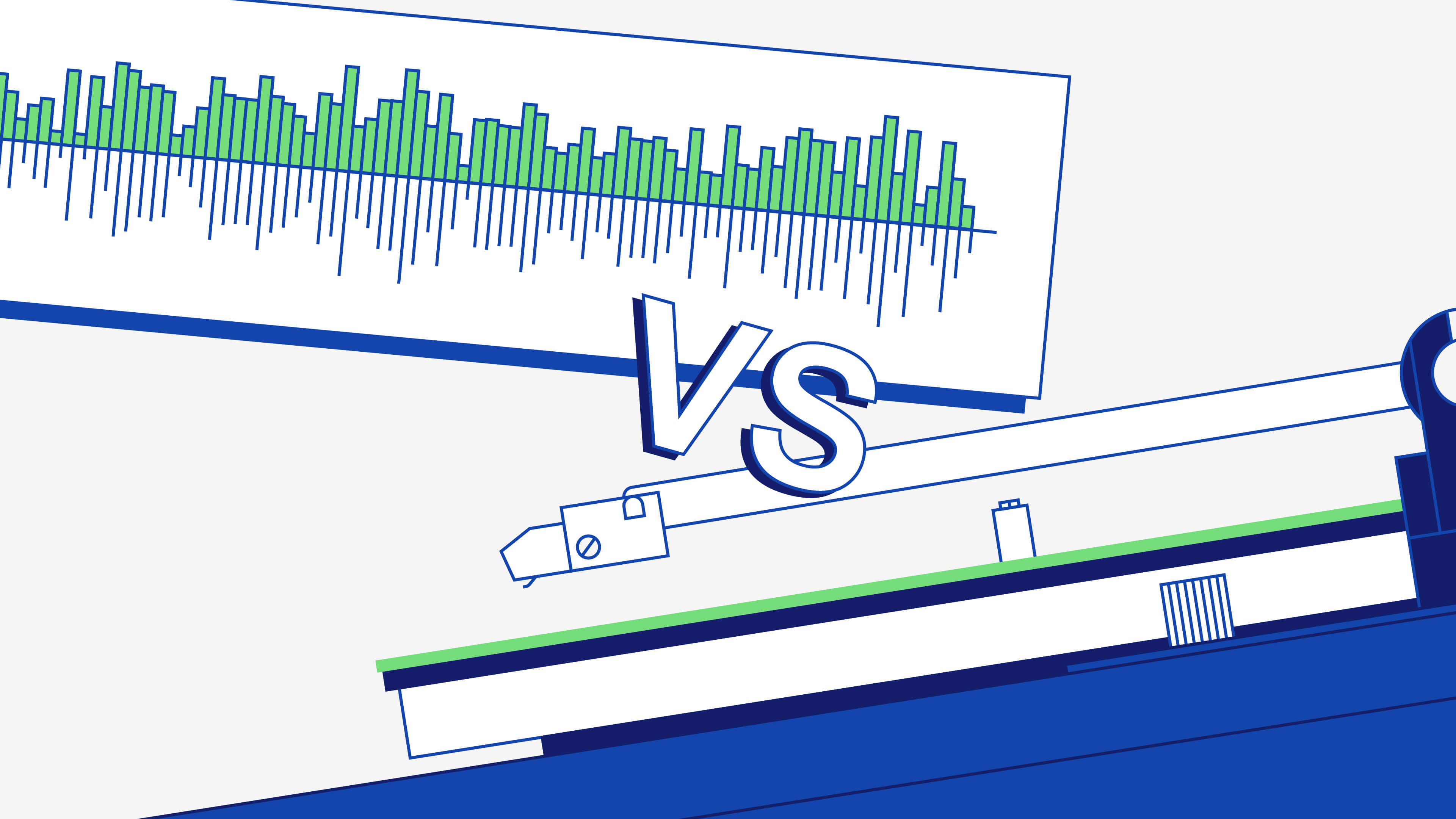Digital vs analog: is analog music better than digital?
Does analog sound better than digital? Is analog hardware a good choice for recording music at home?
Both digital and analog recording equipment can elevate your recordings to new heights. Both have great benefits and also drawbacks, and the subsequent equipment of each operates very differently.
Here are the topics we’re exploring to attempt to answer this question:
- What are the differences between analog and digital signals?
- How analog recording works
- Recording with digital audio
- Analog playback vs digital playback
- Analog distortion vs digital clipping
- Analog tape decks vs digital audio interfaces
- Conclusion: is analog better than digital audio?
Let’s go!
What are the differences between analog and digital signals?
The biggest difference between analog and digital audio signals is that analog signals are electrical whereas digital signals are binary.
But, consequently, there are three differences that relate to how we interact with each.
Signal storage
First and foremost, how information is stored is the biggest difference between analog and digital recording.
For example, analog equipment stores audio information by creating a magnetic charge along magnetic tape.
Another example is vinyl where impressing physical grooves on the discs creates a track for a turn table stylus to run through. Then the stylus recreates the electrical signal via a thin wire in the stylus.
And in contrast, digital audio stores information as binary data (1s and 0s), otherwise known as digital data.
Computers are digital systems and their hard drives store information as binary data that we can access on the system.
Signal distribution
Secondly, analog gear distributes audio information via electrical current. The fluctuations in the strength of the current reflect the peaks and troughs of the sound wave, allowing for accurate reproduction of the audio amplitude levels via a speaker.
Microphones are analog equipment. While recording with a microphone, it converts soundwaves into an alternating electrical signal that your audio interface or tape deck can receive.
But your computer can only read binary information. So your audio interface converts the electrical signal into a digital one and distributes it to your computer.
Signal processing
Finally, analog equipment processes audio via electrical current too. Outboard units like EQs utilize line-level voltage to process audio signals.
In other words, we can add effects and apply processing to analog signals by manipulating the electrical signal.
And, you guessed it, digital audio does so by manipulating binary data that holds the information about the digital audio.
How analog recording works
Now that we have a brief understanding of analog signals, we can put them in the context of recording equipment.
Digital signals are binary and are ‘transparent’ more often than not, whereas analog signals are electrical signals.
So if you’re looking for a warm recording with some vintage characteristics, analog equipment is the way to make that a reality.
Analog recording equipment has been around for a long time. In fact, Alexander Graham Bell patented the first microphone in 1876!
As we discussed above, microphones are an analog recording method that convert soundwaves into alternating current (AC).
Then we can imprint this signal onto analog master tapes through magnetization with large reels or cassettes, or onto vinyl records with spiral grooves.
Whereas today we would use an XLR cable to transport our electrical signal to our audio interface, true analog recording imprints the signal directly onto tape.
Recording with analog tape decks
Analog tape is the highest quality analog recording and playback option.
Here we can store the electrical current from our microphone as charges on long magnetized tape.
You can somewhat liken this process to the digital to analog conversion.
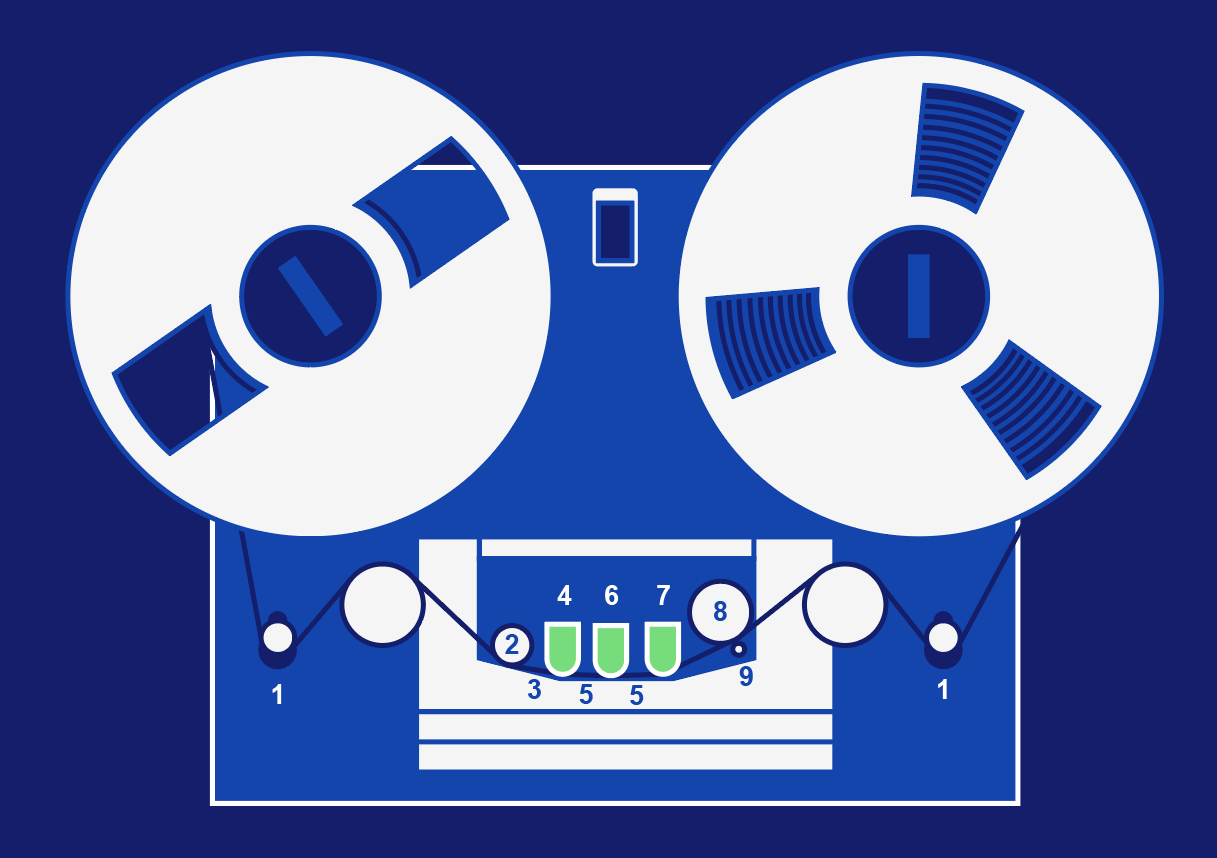
The supply wheel (left) is where the magic begins. From here, a motor and the takeup wheel (right) wind the tape past the heads (4, 6, 7).
Each head features metal coils. And when the coils in the record head (6) receive electricity it creates a small magnetic field.
As the tape passes through this magnetic field, its magnetic particles align relative to the strength of the magnetic field.
Furthermore, both the loudness and pitch of the recording dictate the particles to align in different patterns
And to play these charges back, we need to convert them back into an electrical signal to power speaker cones and play them as sound.
To do so, we need to wind the tape back past the play head (7). Then the pattern of the tape particles re-produces the electrical signal that speakers can read.
While tape is the highest fidelity playback option for playback, it’s easily destroyed by too much magnetic exposure.
Tape and magnetic charges
Let’s take a look at the process of recording with tape a little closer.
A tape machine sends the electrical signal through a coiled wire in the record head which surrounds a magnet; creating the magnetic field.
With the magnet is in close proximity to the tape we can print the currents as charges on the tape.
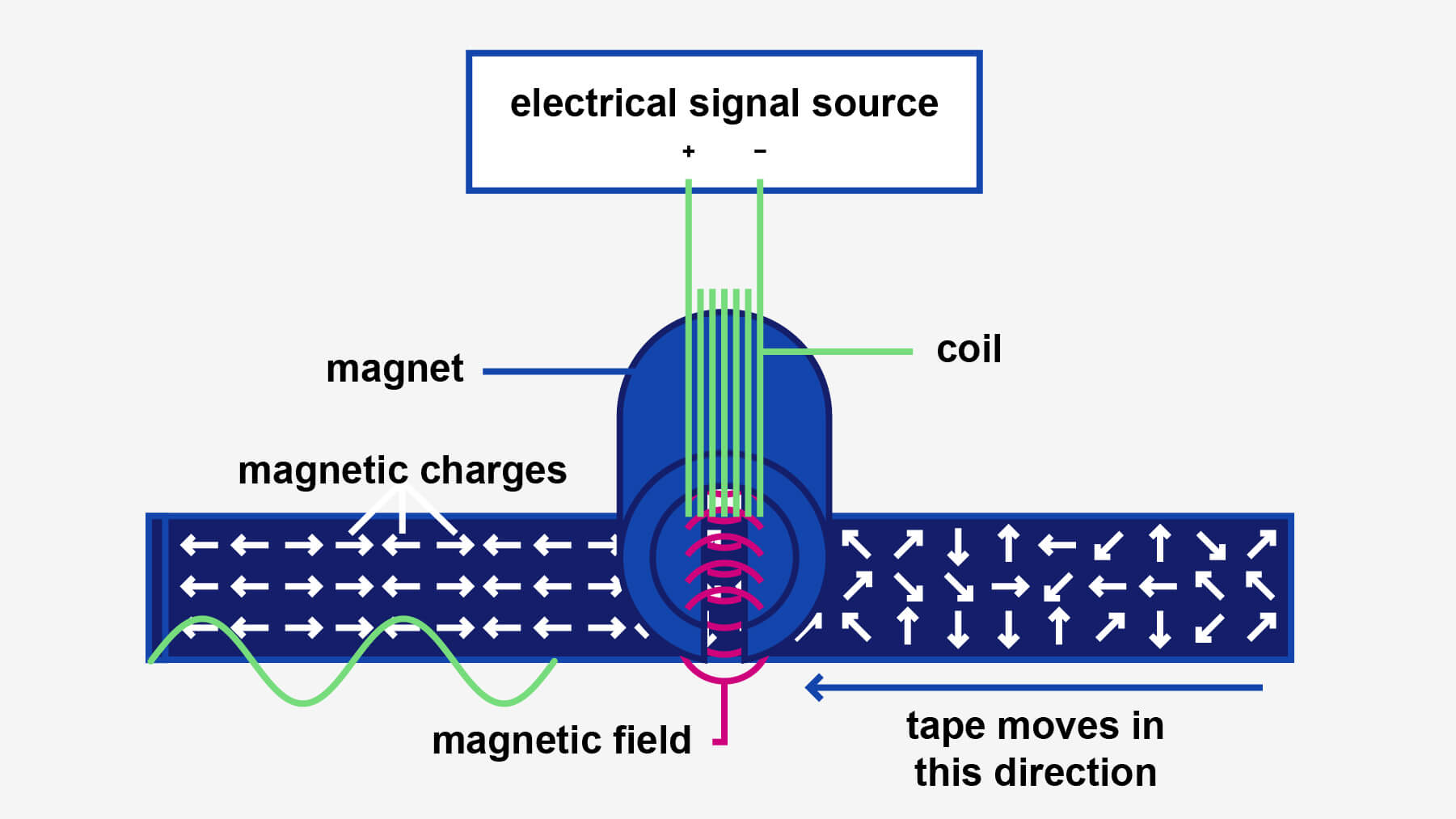
As the tape passes through the magnetic field it magnetically charges particles along the tape. As a result, the imprinted magnetic charges along the tape resemble the fluctuations of the electrical signal.
More specifically, the magnitude of the magnetic charges on the tape resembles the amplitude levels in the recording.
Various characteristics of tape can affect the end quality of the recording. The two biggest variables are tape speed and tape width.
Tape speed
Measured in inches per second (IPS), the speed that the tape passes through the magnetic field has an impact on audio characteristics such as frequency.
For example, recording with faster moving tape creates a recording with more accurate frequency response, shorter dropouts and less noise.
The standard tape machine speed for professional recording is 15 IPS, but other examples include 7-½ IPS and 30 IPS.
Tape width
As for the width of tape, a wider tape allows for a heavier recording as you can capture more information.
In fact, you can record multiple sources at once with wider tape and play them back independently too.
While we can destroy magnetic tape with too much magnetic exposure, the quality of cassette tapes degrades over time due to age, repetitive playback, or copying of the audio content.
In contrast, vinyl records are not phased by magnetic fields.
Playback with vinyl
From our discussion, you may realise that mass-producing tapes for consumption is an expensive course of action.
Well, that’s where vinyl comes in. We copy the audio, stored as magnetic charges, from tape to vinyl by impressing physical grooves on the surface of the vinyl.
It’s worth noting that vinyl is only a method of playing back audio.
The depth of the grooves dictates the amplitude. Therefore as the vinyl stylus goes deeper into the groove, the audio is louder at that point in time.
The more powerful a sound is, the more intense a groove is, thus moving the stylus more aggressively.
Furthermore, the left and right sides of the groove oscillate with respect to the frequency of the audio.
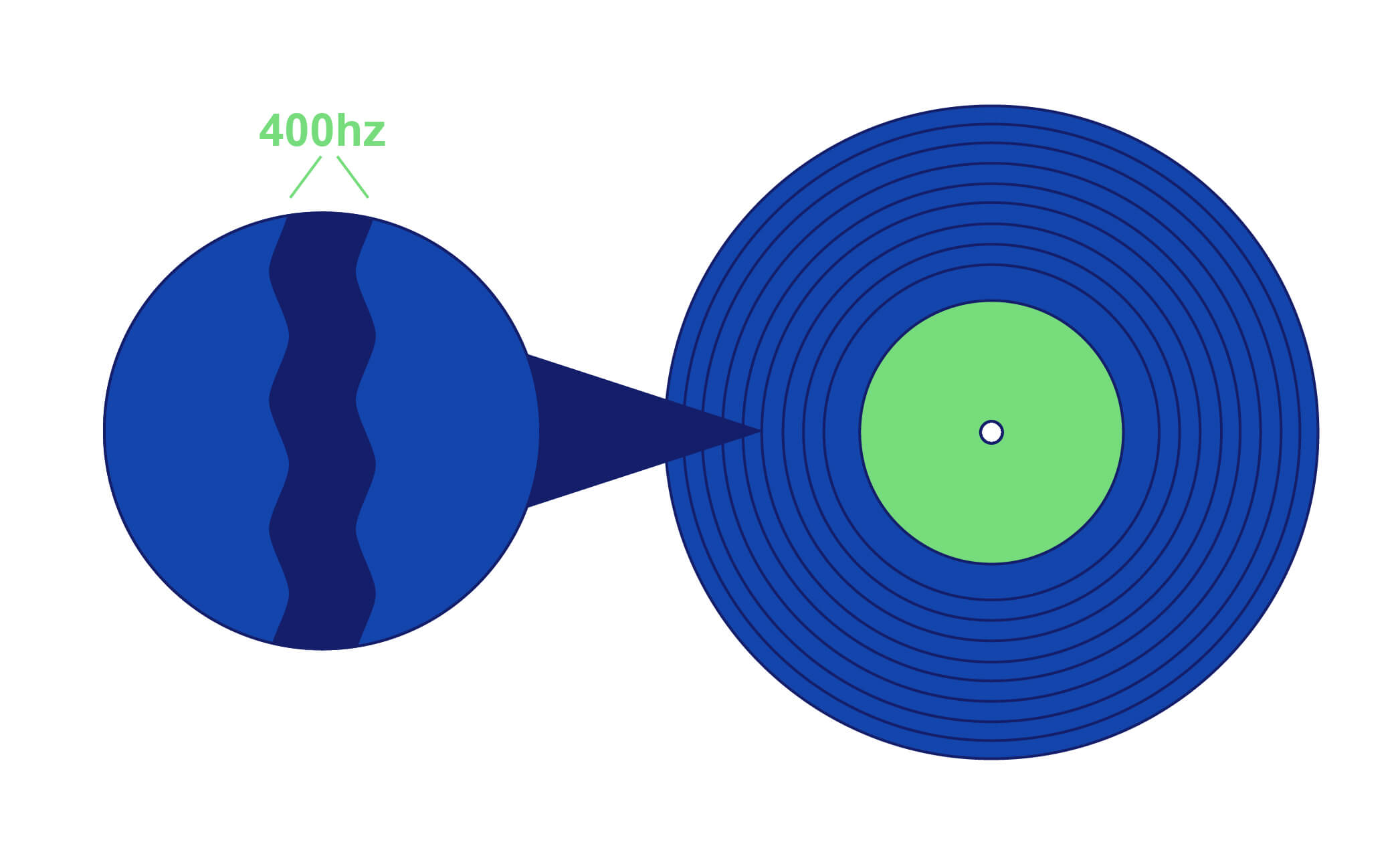
And some vinyl has stereo capability too, meaning the frequency can be different in the left and right channels.
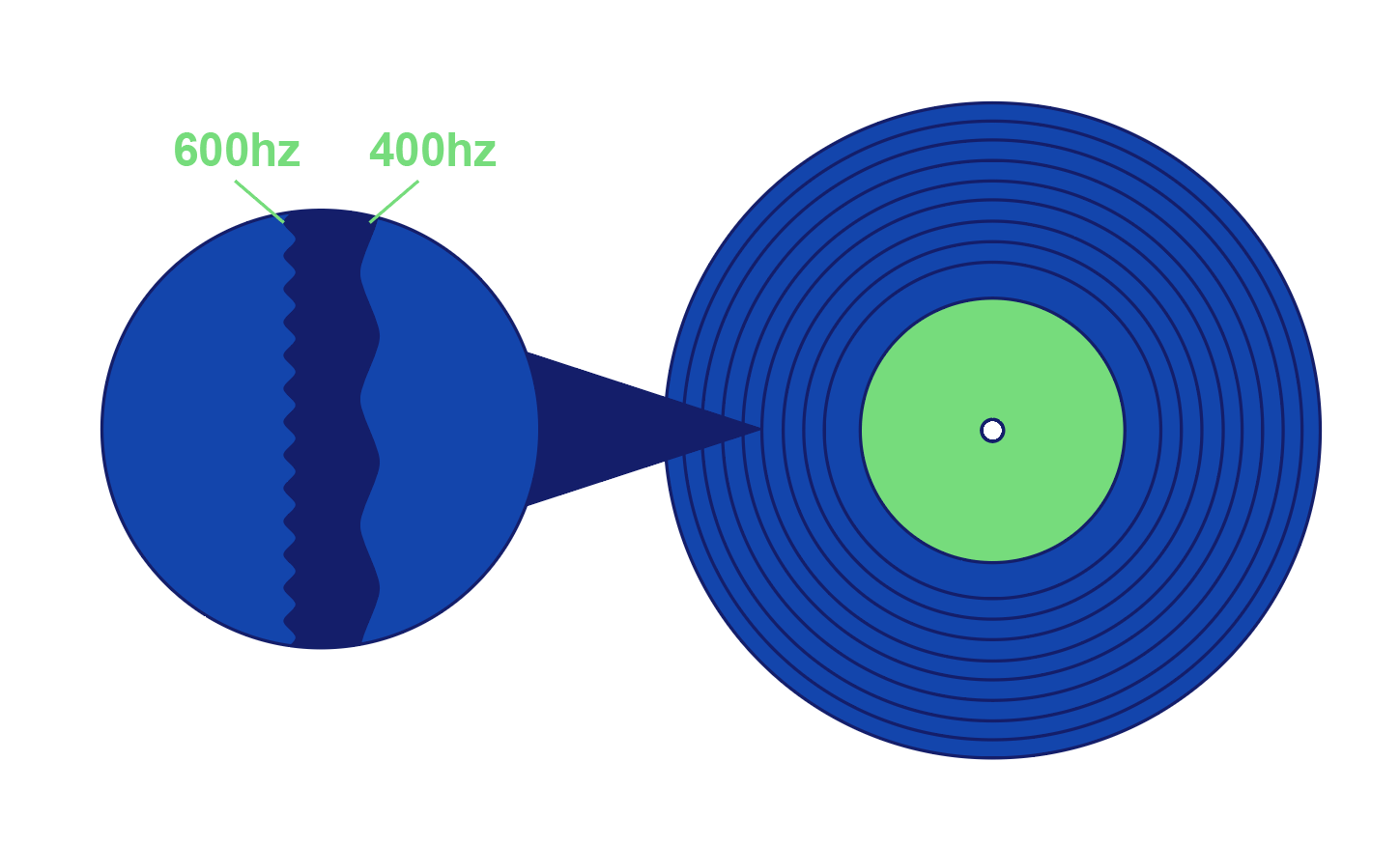
With the vinyl disc spinning at a specific rate, the stylus travels through the grooves. The shape of the grooves tell us about the frequency of the audio and the depth of the grooves tells us the amplitude.
As the stylus moves back and forth with the grooves, it generates an electric current in an internal wire connecting the stylus to an amplifier for playback through speakers.
Like tape, the quality of vinyl recordings degrades over time with repetitive playback and age.
And vinyl doesn’t have the quality of the original recording either. However, it is far easier to produce and distribute vinyl en masse than tape.
Recording with digital audio
But digital audio recording wins over analog for audio fidelity, signal distribution, and ease of storage.
For example, digital recording allows us to copy our recordings onto compact discs (CDs), portable hard drives, or upload them online for distribution.
And unlike analog playback methods, digital playback does preserve audio fidelity!
Digital recordings maintain 100% audio fidelity forever thanks to safe digital storage. No matter how much you play, copy, or paste the file, it will maintain its quality.
However, recording a digital signal still requires a microphone to convert an acoustic soundwave into an electrical signal.
Now, analog recording operates solely with electrical signals. But we must go one step further than analog equipment to distribute electrical signals to a computer as binary.
This additional process is fittingly known as analog to digital conversion.
What is analog to digital conversion (ADC)?
Analog to digital conversion (ADC) is the process of converting an electrical signal into a digital one. As a result of ADC, computers can read and reproduce our recordings in digital format. And at the core of ADC is sampling.
The image below is a brief example of how digital recording gear like an audio interface takes snapshot samples of a sound wave.
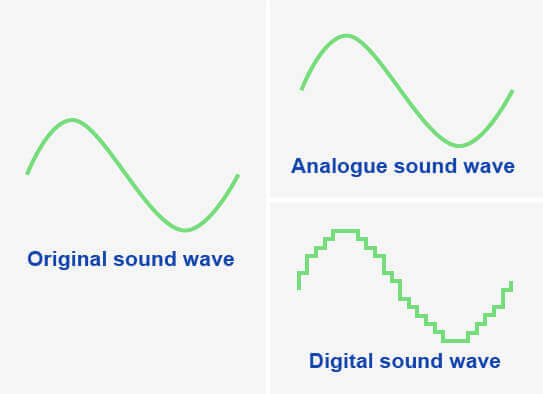
The analog signal reflects the original sound wave perfectly whereas the digital signal does not. We will come back to this, but for now this basic visual demonstrates we must sample our input to reconstruct it as digital.
So rather than working solely with an electrical signal from a microphone and imprinting them onto tape as charges, digital recording uses ADC and to take samples of the original soundwave and converts the electrical signal into a digital one.
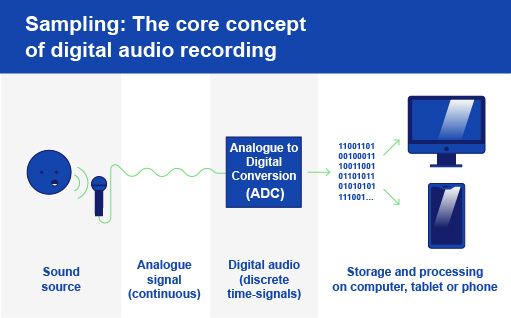
ADC allows digital recording equipment like a USB audio interface to capture every detail of a soundwave like analog tape recording can.
However, the quality of your digital recording – and therefore its resemblance to the original signal – depends on the bandwidth of your digital recording.
What is audio bandwidth?
Audio bandwidth is the resolution of a digital recording.
In other words, audio bandwidth determines the audio quality, meaning it determines the accuracy of the recording to the original performance.
More bandwidth = more accurate reproduction
Two specifications make up audio bandwidth:
- Bit depth
- Sample rate
Recording with a higher sample rate and a bit depth gives you a higher audio bandwidth; giving you better audio quality.
So if you are looking to drop jaws with supreme audio quality, greater bandwidth is important. This is especially true if you’re listening through high-quality speakers like near-field monitors.
In contrast to analog tape recording where the quality is determined by tape speed and width, the quality of a digital recording is determined by sample rate and bit depth.
What is sample rate?
Sample rate is the number of sample measurements and the speed at which they’re taken per second, measured in kHz.
If we want to reproduce our performance accurately, we must take thousands of samples per second during the analog to digital conversion.
The common sample rate is 44.1 kHz. In other words, 44,100 samples per second.
Take a look at this image:
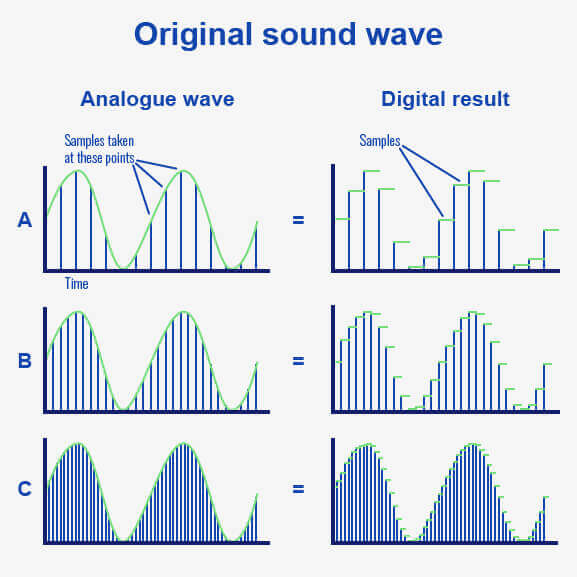
The digital result in example A is blocky and it doesn’t capture the smoothness of the original audio signal. It’s the result of taking too few samples of our sound wave.
But the digital result in example 2 takes more samples and gives a closer representation of the original audio.
However, we’ve taken enough samples to reconstruct the audio signal accurately in the final example.
After sampling our recording, our computer must store it. And computers store information in bits.
What is bit depth?
Bit depth describes the number of available bits that digital gear can map a signal’s amplitude values to.
Because sound waves have a countless number of possible amplitude values, we need to establish their amplitude values as bits to measure them accurately in the digital realm.
If you had a digital image with 4000 pixels (4K) but a low bit depth, its coloring wouldn’t be very exotic despite the potential details available with 4K.
Likewise, a 1-second audio recording with a 96kHz sample rate but an 8-bit depth limits how we can map those 96,000 samples to digital bits.
Below you can see how sample rate and bit depth work together to reconstruct one wave cycle in the image above.
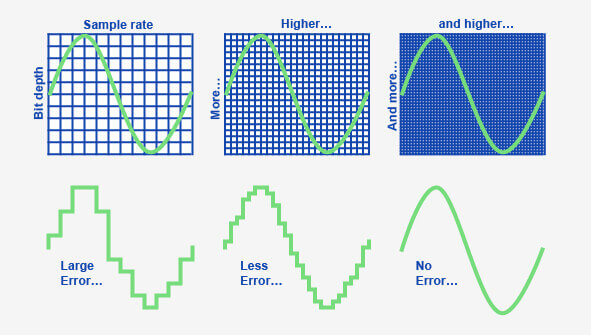
Bit depth and sample rate work in conjunction with each other.
If you take 96,000 samples of a sound wave but do not have enough bits to store those samples then your digital audio will not sound great.
In the first example, the digital sample sound is too blocky in comparison to our original sound.
In the second example, the audio is less blocky but still not perfect.
Finally, it’s in the third example that we have enough bits to reproduce our smooth sound wave.
CD quality audio of 44.1kHz/16-bit provides enough audio resolution to create an accurate reproduction of our audio. The lowest bit depth for good audio quality is 16-bit.
And now we can talk about playback in better detail…
Analog playback vs digital playback
As far as playback is concerned, digital audio trumps analog every time.
We can burn digital signals to CDs, copy them to hard drives, and send them to the other side of the world over the internet – all without degrading in quality.
As a result, anyone with a smartphone can access millions of songs.
As we can play digital audio files as much as we like without degrading their quality, analog playback almost seems redundant.
We can only play analog audio on tape on vinyl players! And, as we discussed earlier, they degrade in quality with more plays over time too.
Despite their inferiority, analog playback still has its place.
Many people prefer the warmth and vintage character of analog equipment. And that’s true for both recording and playback!
Whether it’s that signature vinyl crackle or a particular microphone tone, analog equipment isn’t out of mind just yet…
Analog distortion vs digital clipping
A very big difference between analog and digital recording is the distortion they produce when we overdrive the different pieces of equipment.
If you were to send your signal through a piece of analog gear too hot, you’d notice that the distortion doesn’t sound like it does in a DAW…
What is analog distortion?
Analog distortion occurs when we overdrive the electric circuits and transistors in analog equipment.
Overdrive your signal through different pieces of analog equipment and you’ll notice how the distortion sounds different with each bit of kit too.
The quality of the signal will change as it reaches the ceiling of the analog gear, meaning it is non-linear distortion. Your output signal will differ from your input signal as a result.
There will be frequencies present in the output sound that are not present in the input. And these additional frequencies are elements of distortion that the analog gear has inserted.
In other words, analog distortion will have unique characteristics based on the equipment you’re using. It will depend on the circuit and internal build of the gear!
And as the distortion can change based on the gear and often sound pretty nice, there are more creative applications for analog distortion than clipping.
In fact, analog distortion can often sound warm, vintage, and incredibly pleasing. Clipping just sounds nasty…
What is digital clipping?
Clipping occurs when we overdrive a signal higher than 0 dBFS (Decibels Full Scale) in a digital system.
So where an analog signal would distort based on the circuitry of the equipment, our digital system uses an algorithm to generate ‘clipping’.
Though the sound of clipping (a horrible static in your signal) is algorithmically generated, clipping your signal does have consequences.
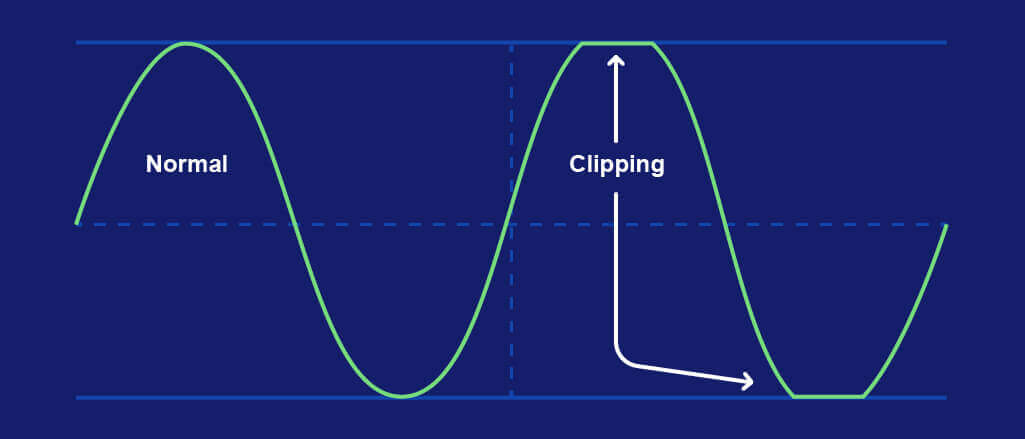
Overdriving your digital signal squares off the signal, meaning the ceiling and floor flatten the positive and negative amplitudes.
As digital clipping is algorithmically generated, it doesn’t inherit any unique characteristics of any gear. Clipping sounds the same no matter what DAW you’re using!
Analog tape decks vs digital audio interfaces
To assess the pros and cons between analog and digital equipment, I think we should compare analog tape decks and digital audio interfaces.
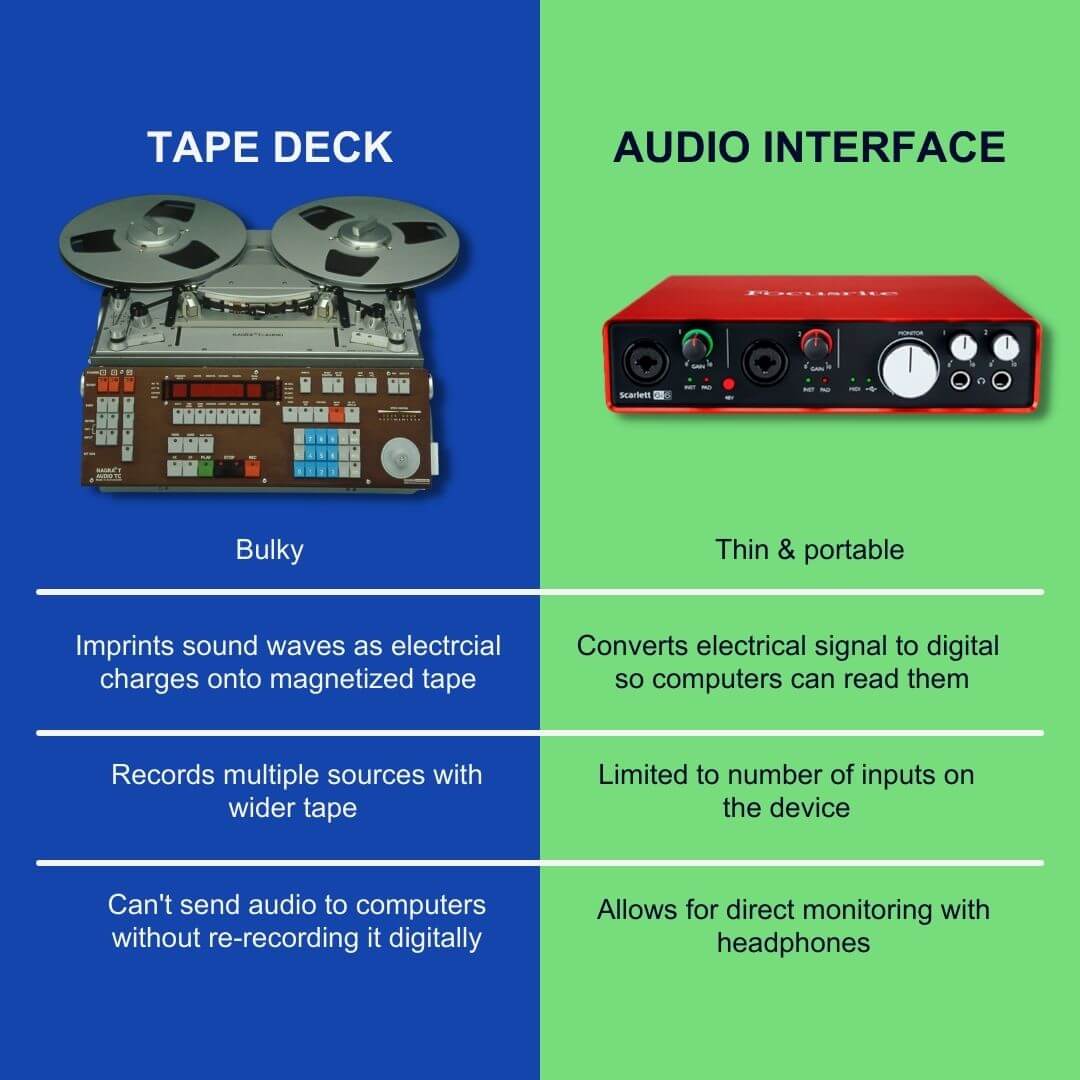
In this battle of digital vs analog music, we can see that digital music empowers independent artists around the world to record and make music in home studios.
Despite the artistic benefits of analog recording, the equipment is far bulkier. As another matter, rooms and houses seem to be only getting smaller. Therefore big analog tape decks just won’t suit many people’s space requirements!
But an audio interface will sit neatly in a space far better, whether on a desk or even a backpack!
Conclusion: is analog better than digital audio?
The advantages and disadvantages between analog and digital are more or less subjective. There isn’t an objective “best” between analog and digital production!
For example, the coloration that analog equipment can provide can be an artistic preference as opposed to the transparency of digital algorithms.
Another benefit of recording with analog is that analog recordings have “unlimited bandwidth”. Subsequently, we can lower the resolution of analog recordings and avoid compromising audio fidelity whatsoever.
On the other hand, digital audio uses sample rate and bit depth to reconstruct the analog signal in the digital realm, and these create a fixed bandwidth.
So if you’re asking “does analog really sound better than digital?” you need to consider your musical taste, but also your budget.
If your budget doesn’t stretch very far then think about keeping it digital for the time being. Digital recording and production equipment are far more affordable than analog equipment.
In fact, affordability is where digital audio trumps analog again.
Once upon a time, only professional studios could afford to record music. Artists had to book slots with expensive studios to record onto tape in those days.
Now, anyone with a laptop or even a smartphone can do so.
On top of that, analog equipment takes up a lot more space than most digital equipment!
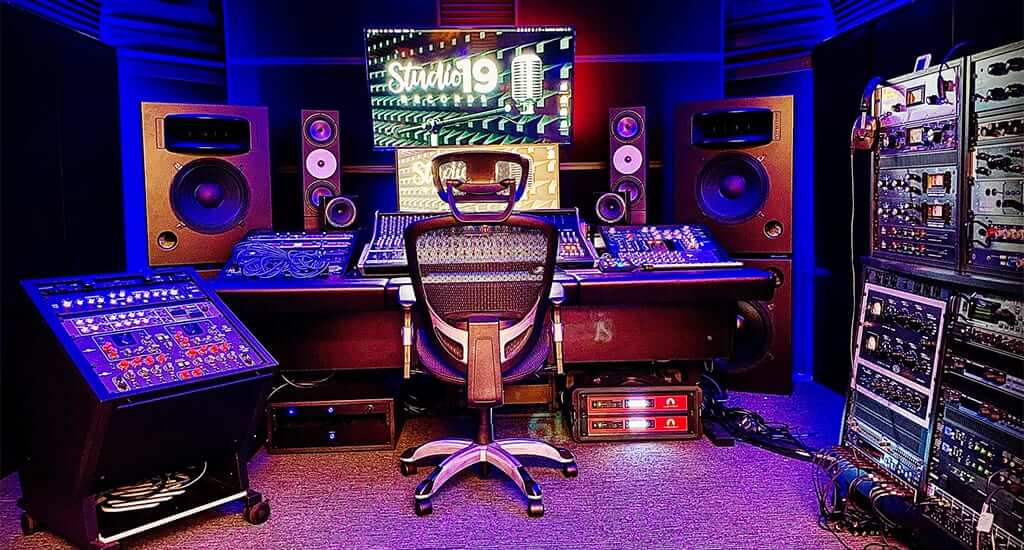
Image Credit: Studio 19 Records
Finally, if you want fans to hear your music to find your music on streaming services then it’ll need to be digital in the end. Anyone with a smartphone can access millions of songs with just their fingertips, thanks to the digital revolution.
So, how are you going to record your next hit?
